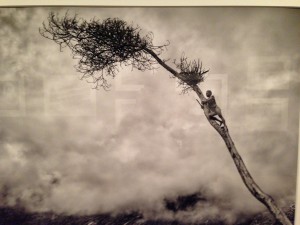Currently featured at the International Center for Photography (ICP) is a show by Sebastiao Salgado on the topic of climate change. The collection of photographs is entitled “Genesis.” This collection of images attempts to call to our attention the state of the earth’s global climate and how it affects daily lives.
Contained in the exhibit were images taken from all around the world. It featured a total of 5 sections titled, Northern Spaces, Sanctuaries, Africa, Amazonia and Pantanal, and Planet South. Each of the sections contained several photographs which featured images from the corresponding part of the world. The photographs ranged from capturing daily life in idyllic tribal villages, to vast landscapes which peered off into the distance, and animals in their natural habitat. All of the photographs were printed in black and white. This gives the images a very bland mood, the lack of color causes the viewer to stand back and appreciate the photograph as a whole, instead of calling to our attention the various hues which might distract from the message.
The photographs of people living in tribal villages were especially eye catching. They are featured in their daily dress, going about mundane daily chores. Each seemed to lack expression on their face. Almost as if they did not fully comprehend they were being photographed. This innocence gives the images a more powerful impact. The subjects are in a natural state which is difficult to recreate with a typical subject who is conscious of the camera. The one thing which I noticed to be lacking from the exhibit were any photographs of the destruction currently taking place in the world’s forests. I went to the show expecting to see how horrible we as human beings are treating our environment, or how industrialization is destroying the ozone layer. However what I came to find was not what I had expected. There were breath taking scenes photographed from obscure angles and a variety of animals, either carelessly lounging or traveling great distances in large herds.
One photograph which I connected with was the image of a man climbing a tree. The tree is leaning drastically to the left and has barely any leaves on it. The man is perched about half way to the top on a knot which sticks out. The photo was taken from a low angle from the ground. So it appears as if he has climbed the tree high enough to reach the clouds. The man in the photo appears distant and all alone. To me this particular image translated the message of climate change. The man on the tree represents the human population and the tree symbolizes the environment. The man is climbing the tree possibly to take something from it. During the climb, his weight is increasingly bearing down on the tree. Causing it to bend significantly. This can directly translate to our current relationship with the environment. We continually take from the planet at the risk of destroying what remains. Rather than giving it time to flourish, we needlessly consume resources.
On the whole this exhibit portrays the beauty of the world and the people and animals which live in it. In spite of the title, most of the photographs have nothing to do with the climate changing, but rather shows us what exists today. In this aspect we can appreciate what we already have and possibly be more inclined to do what it takes to make it last so that future generations can develop the same respect.





You point to a real contradiction in the Genesis exhibit. The photographs show the world as wild and untouched and native peoples as if they are able to live with no contact with western technology. I agree that the question is whether these photos promote concern about climate change or if they promote a sense that nature, somewhere out there where most of us never go, is ok.